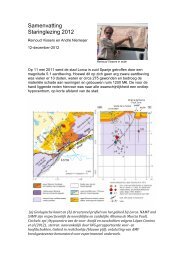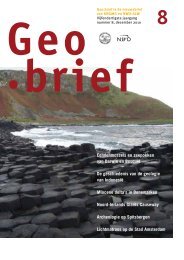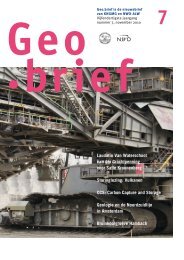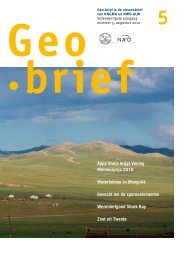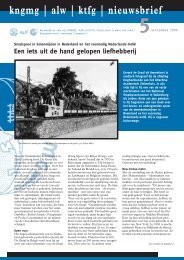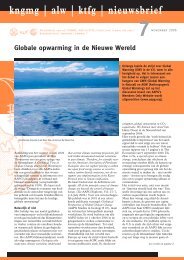Geobrief 2 - kngmg
Geobrief 2 - kngmg
Geobrief 2 - kngmg
You also want an ePaper? Increase the reach of your titles
YUMPU automatically turns print PDFs into web optimized ePapers that Google loves.
Ice deformation apparatus schematic (left) and in ‘real life’.<br />
exists is a daunting task. It can take large<br />
amounts of strain for a solid aggregate to<br />
approach textural equilibrium and lab<br />
strain rates for measurable GSSflow in<br />
ice are low. A direct approach of imitating<br />
geology is therefore impractical. The solution<br />
is to use a ‘bracketing’ technique, i.e.,<br />
demonstrating that the direction of change<br />
over a relatively small strain ( 103°C and strain rates<br />
between 10 −8 s −1 and 10 −4 s −1 were chosen.<br />
Two types of starting material were<br />
used. Finegrained ice (~2 μm) and coarsegrained<br />
ice (~250 μm). The deformation<br />
apparatus was a 1.0 GPa gas deformation<br />
apparatus which can be used for cryogenic<br />
conditions. N2 gas is used as confining<br />
medium. The ice samples in the gas vessel<br />
are deformed axially by an upward moving<br />
piston.<br />
Where do we go?<br />
Results of the extensive set of grain growth<br />
experiments and the deformation experiments<br />
on both coarse and finegrained<br />
ice are in now. Grain growth laws and<br />
deformation mechanism maps are on their<br />
way to be calibrated. However, ice appears<br />
to behave in a more complex way than<br />
anticipated. Nevertheless, grain size<br />
clearly cannot be ignored as an important<br />
parameter in the flow of planetary ice, and<br />
this conclusion must probably be expanded<br />
towards terrestrial ice. With the results<br />
we can assess largescale implications by<br />
applying the obtained mechanismbased<br />
description in building and calibrating<br />
numerical models. This numerical modelling,<br />
for which we will collaborate with<br />
Bert Vermeersen from TU Delft, is, at the<br />
moment, the only possible way to describe<br />
tectonic and thermal processes on icy<br />
moons.<br />
Sabrina Diebold<br />
This project is funded by NWO/NSO (The Netherlands Organisation<br />
for Scientific Research and the Netherlands Space Office), as<br />
part of the User Support Programme Space Research, subprogramme<br />
Comparative planetology. Supervisors are Hans de Bresser<br />
and Chris Spiers (Utrecht University) and William B. Durham<br />
(MIT, US).



